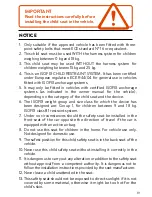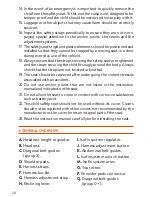
20
14. in the event of an emergency it is important to quickly remove the
child from the safety seat. To this end the clasp is not designed to be
tamper-proof and the child should be instructed not to play with it.
15. Luggage or other objects that may cause harm should be correctly
secured.
16. inspect the safety straps periodically to ensure they are not worn,
paying special attention to the anchor points, the seams and the
adjustment systems.
17. The safety seat’s rigid and plastic elements should be positioned and
installed so that they cannot be trapped by a moving seat or a door
during everyday use of the vehicle.
18. Always ensure that the straps securing the safety seat are tightened
and the straps securing the child fit snugly around the body. Always
check that the straps are not twisted or knotted.
19. The seat should be replaced after undergoing the violent stresses
associated with an accident.
20. Do not use anchor points that are not listed in the instruction
manual and indicated on the seat.
21. Do not allow the seat to come in contact with corrosive substances
such as battery acid.
22. This child safety seat should not be used without its cover. Covers
should not be replaced with other covers not recommended by the
manufacturer as the cover forms an integral part of the seat.
23. Read the instruction manual carefully before installing the seat.
1. GeNeral oVerVIeW
a. Headrest height regulator.
B. Headrest.
c. Diagonal belt guides
(group 2).
d. Shoulder pads.
e. Harness straps.
F. Harness buckle.
G. Harness adjustment strap.
H. Reclining lever.
I. isofix system regulator.
J. Harness adjustment button.
K. Abdominal belt guides.
l. isofix system unlock button.
M. isofix system arms.
o. Top tether.
P. Shoulder pads connector.
Q. Diagonal belt guides
(group 0+).
















































